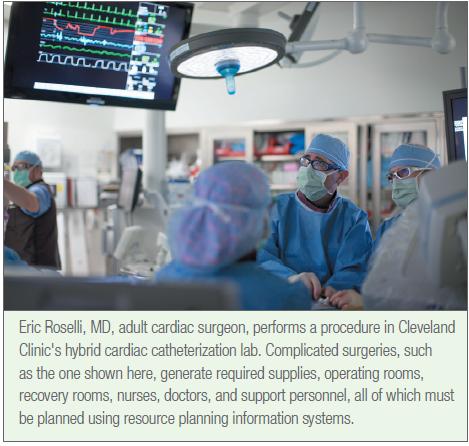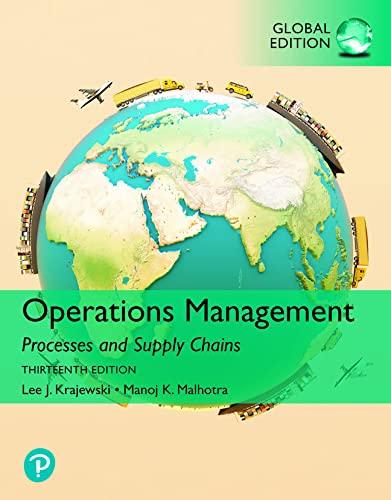Founded in 1921 by four physicians with a mission to provide better care for the sick, investigate
Question:
Founded in 1921 by four physicians with a mission to provide better care for the sick, investigate patient problems, and further educate those who serve, Cleveland Clinic is one of the world's most respected healthcare organizations, offering patients access to its world-renowned healthcare specialists at multiple locations globally. At Cleveland Clinic, the focus is on putting "Patients First." This means a patient experience that includes safe care, high value care, high quality care, and patient satisfaction. The effort has not gone unnoticed. For 26 consecutive years, U.S. News and World Report has recognized Cleveland Clinic as #1 in cardiology and heart surgery, with an additional 13 specialties ranked in the Top Ten.
According to its website, to deliver on this "patient-centric" promise requires more than world-class clinical care--it requires "care that addresses every aspect of a patient's encounter with Cleveland Clinic, including the patient's physical comfort, as well as their educational, emotional, and spiritual needs." Cleveland Clinic was the first major academic medical center to make patient experience a strategic goal, appoint a Chief Experience Officer, and establish an Office of Patient Experience.
Each patient at the Clinic generates a demand for activities and supplies used in the hospital, which we term dependent demand. To support its patient centric approach, Cleveland Clinic's Supply Chain and Patient Support Services team has been on a journey of establishing a foundation of strategic sourcing that places emphasis on understanding this dependent demand and how to fulfill it to maximize patient outcomes. This journey is supported by an innovative program that seeks to align supply chain support across all levels of care, from pre-operative through to patient discharge.
The Cleveland Clinic performs a large number of complicated surgeries and procedures on a daily basis. Each of them has its own set of required resources that are much too voluminous to mention here, but include assorted material supplies, operating rooms, recovery rooms, nurses, doctors, and support personnel among others. The timing and quantity needed of a given resource is aggregated across each patient's specific type of surgery or procedure and their associated schedules. Cleveland Clinic thus manages dependent demand by focusing on the specific needs of each patient and then working backward through each level of care similar to the bill of resources depicted in Figure 11.21. Resource planning at Cleveland Clinic ensures that all services, supplies, and staff necessary for the proper care of a given patient at different stages of care are available at the time needed.
A simplified example of this resource planning approach can be seen in the workflow for how the nursing staff handles flushing intravenous tubing lines (IVs) with medicine to keep them from becoming blocked. The daily demand for IV usage is driven by the aggregated number of surgeries and procedures scheduled each day. Following Cleveland Clinic's Clinical Care protocols for patient care, a nurse is required to flush an IV line with the drug Heparin to prevent the tubing from being blocked. To physically complete this protocol, the nurse retrieves a pre-filled Heparin flush syringe from a supply cart, usually inside or close to the patient room. This action is performed multiple times a day for every patient on the nursing floor that has an intravenous line or port.
At some point in the day, the nurses need to replenish that drawer with the pre-filled Heparin flush syringes. These supplies are stocked in a nearby supply location managed by the Supply Chain organization, which requires notification
when the Heparin runs low to assure there are no stockouts at a critical time in the patient care process.
As the nursing staff remove Heparin flushes from the supply carts, the on hand inventory is reduced or even depleted. If a floor has multiple patients on IV and port catheters, the demand for the Heparin flush will increase. If the medical floor has very few patients on IVs, the Heparin flush usage is reduced. The future estimates of patients requiring IVs is important in keeping enough Heparin in stock.
This process is repeated for hundreds of items that are required to deliver daily therapies for a patient. Each of the supplies has its own pattern of usage. The Supply Chain organization has to understand all the dependent demand patterns from the patient that drive the need for supplies at the internal supply locations and then to the external vendors and manufacturers.
This "Patient-Centric Supply Chain" is responsive to the demand pull of a nurse retrieving items required to administer a prescribed therapy. The goal of "patient first" drives the physical flow of items to come through the supply chain process, starting at the receiving dock (operations) and moving through the hospital's various supply locations to the supply carts, and eventually to the nurses and patients.
Historically, point-of-care supply locations in hospitals were always managed by nurses. Surgical and procedural areas limited access to those areas and a physical "Red Line" was often painted on the floor designating it as a "Staff Only" area. Supplies used behind the Red Line were always considered too unique and complex to be managed by a logistics organization that was mostly focused on lower cost, high velocity common items such as bedpans, gloves, sponges, gauze, needles, syringes, bandages, and Heparin flushes.
The Supply Chain organization would previously service the needs of Surgical and Procedural areas by processing the departmental supply requests and delivering requested items to drop off locations, largely staying outside of the patient care work streams behind the red lines. But all that changed with the Patient-Centric Supply Chain. Now, the supply chain organization is able to cross the Red Line to replenish needed items as they are pulled by the clinical staff so there is never a risk of outage on the carts.
QUESTIONS
1. Explain how the concepts of dependent demand and bills of resources are being used at the Cleveland Clinic. Using Heparin IV flushes as an example, how do these concepts support Cleveland Clinic's "Patient First" focus?
2. Why is Cleveland Clinic's Patient-Centric Supply Chain so vital to the organization's strategic vision and future plans?
3. What might be risked if the supply chain organization is not fully aligned with the entire spectrum of managing dependent demand for a patient from pre-operative care to discharge?
Step by Step Answer:

Operations Management Processes And Supply Chains
ISBN: 9781292409863
13th Global Edition
Authors: Lee Krajewski, Naresh Malhotra, Larry Ritzman





